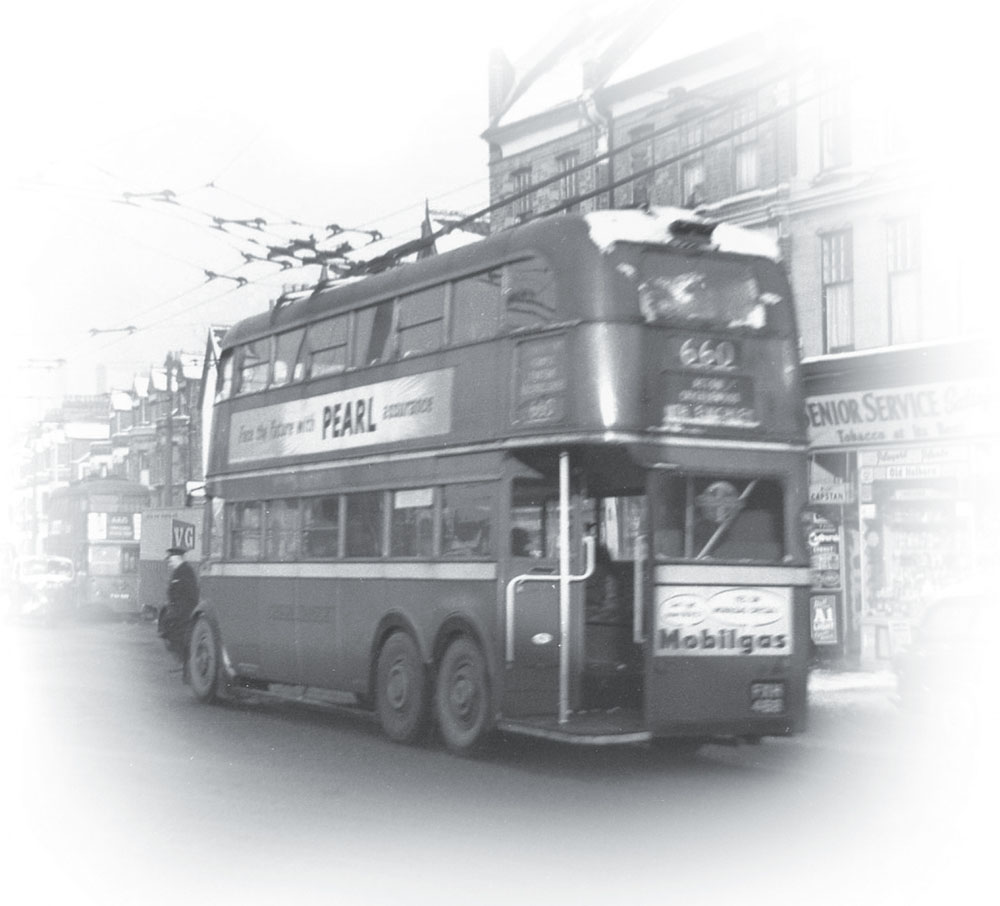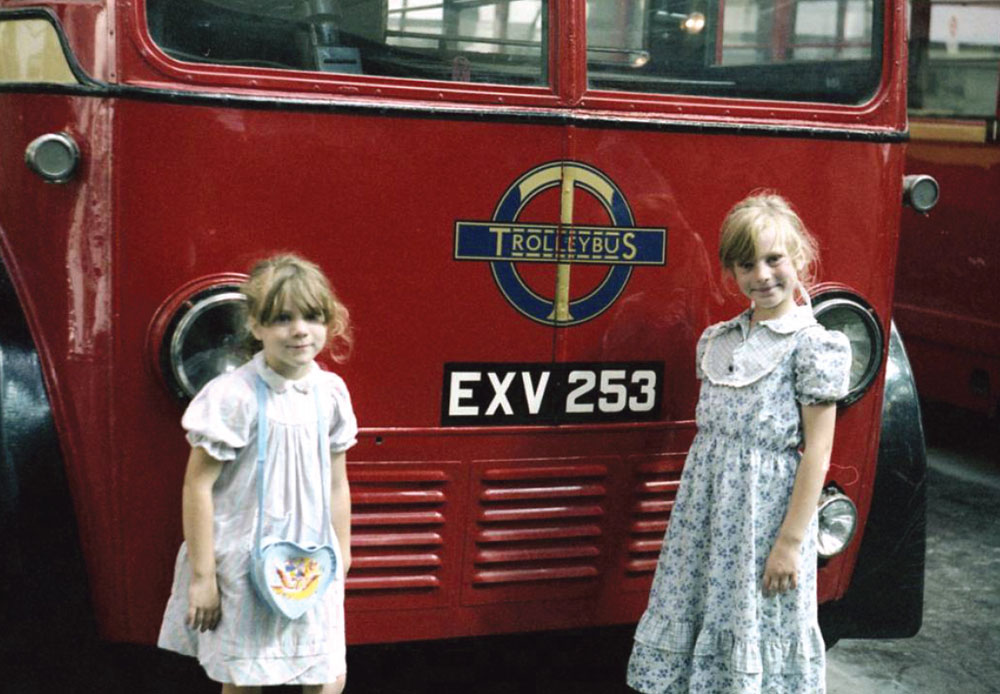

Bournemouth Corporation Weymann-bodied BUT 9641T trolleybus No.256, dating from 1950, heads a line up of its withdrawn fellows at their Mallard Road depot on 15 January 1967.
Although the British trolleybus is usually perceived to be an ‘inter-war’ phenomenon, when trolleybuses were a popular replacement for ageing tramway systems and were indeed in their heyday, trolleybuses had in fact been in use much earlier. As may be seen, some of the early systems were very short lived, yet ironically the city that had been the last to operate trolleybuses in this country, Bradford, was also the first where they operated, albeit on a joint service to Leeds which lasted only until 1928.
Below is a list of British trolleybus systems, in alphabetical order, showing their dates of introduction and withdrawal. Grateful thanks go to the British Trolleybus Society and the National Trolleybus Association for this information. The list is interspersed with a few photographs of trolleybuses working for some of the operators mentioned in their final years.
Aberdare: 15 January 1914 to 23 July 1925.
Ashton-Under-Lyne: 26 February 1935 to 31 December 1966.
Belfast: 28 March 1938 to 12 May 1968.
Birmingham: 27 November 1922 to 30 June 1951.
Bournemouth: 13 May 1933 to 20 April 1969.
Bradford: 20 June 1911 to 26 March 1972.
Brighton (Corporation): 1 May 1939 to 30 June 1961.
Brighton, Hove & District: 1 January 1945 to 24 March 1959.
Cardiff: 1 March 1942 to 11 January 1970.
Chesterfield: 25 May 1927 to 24 March 1938.
Cleethorpes: 18 July 1937 to 4 June 1960.
Darlington: 17 January 1926 to 31 July 1957.
Derby: 10 January 1932 to 9 September 1967.
Doncaster: 22 August 1928 to 14 December 1963.
Dundee: 3 September 1912 to 13 May 1914.
Glasgow: 3 April 1949 to 27 May 1967.
Grimsby: 3 October 1926 to 4 June 1960.
Halifax: 20 July 1921 to 24 October 1926.
Hartlepool: 28 July 1924 to 31 March 1953.
Hastings: 1 April 1928 to 31 May 1959.
Huddersfield: 4 December 1933 to 13 July 1968.
Ipswich: 2 September 1923 to 23 August 1963.
Keighley (Cedes Stoll): 3 May 1913 to 3 May 1926.
Keighley (Standard): 20 August 1924 to 31 August 1932.
Kingston-Upon-Hull: 25 July 1937 to 31 October 1964.
Leeds: 20 June 1911 to 26 July 1928.
Bournemouth was the last British operator to have new trolleybuses delivered, as late as 1962. Typical of these was No.282, a Sunbeam MF2B with Weymann dual-entrance bodywork new in 1959. It is seen in Christchurch on 11 August 1968, eleven months before the system was abandoned.

Seen on 7 October 1967 amid redevelopment in the city centre, Bradford 778 is typical of many trolleybuses the Corporation acquired from other operators. It is a Karrier W new to Llanelli Corporation in 1945, and acquired by Bradford in 1958 and given a new East Lancs body.
By pure chance, I was able to photograph the very last trolleybus to run home to a North London depot on its final day in service, 2 January 1962. This was MCCW-bodied AEC chassissless L3 class No.1468 seen at Craven Park heading homewards around lunchtime that day on route 660. It would bring to an end trolleybus operation in my part of London in the early hours of Wednesday, 3 January when it ran in from this route to Finchley depot.
Trolleybuses usually lasted longer than motor buses, but here on 3 October 1965, Nottingham Corporation 1950 Brush-bodied BUT 9641T No.526 is one of several dating only from the early 1950s that await disposal in the yard of one of their depots. The system closed at the end of June 1966 – ironically trams and not trolleybuses have returned to the city since!
Llanelli: 26 December 1932 to 8 November 1952
London: 16 May 1931 to 8 May 1962.
Maidstone: 1 May 1928 to 15 April 1967.
Manchester: 1 March 1938 to 31 December 1966.
Mexborough & Swinton: 31 August 1915 to 26 March 1961.
Newcastle-Upon-Tyne: 2 October 1935 to 2 October 1966.
Nottingham: 10 April 1927 to 30 June 1966.
Notts & Derby: 7 January 1932 to 25 April 1953.
Oldham: 26 August 1925 to 3 September 1926.
Pontypridd: 18 September 1930 to 31 January 1957.
Portsmouth: 4 August 1934 to 27 July 1963.
Ramsbottom: 14 August 1913 to 31 March 1931.
Reading: 18 July 1936 to 3 November 1968.
Rhondda: 22 December 1914 to 10 March 1915.
Rotherham: 3 October 1912 to 2 October 1965.
St. Helens: 11 July 1927 to 30 June 1958.
Southend-On-Sea: 16 October 1925 to 28 October 1954.
South Lancashire: 3 August 1930 to 31 October 1958.
South Shields: 12 October 1936 to 29 April 1964.
Stockport: 10 March 1913 to 11 September 1920.
Teesside: 8 November 1919 to 18 April 1971.
Walsall: 22 July 1931 to 3 October 1970.
Wigan: 7 May 1925 to 30 September 1931.
Wolverhampton: 29 October 1923 to 5 March 1967.
York (First operation): 22 December 1920 to 31 December 1929.
York (Second operation): 6 October 1931 to 5 January 1935.
A study of the dates of operation does bear out that the heyday of the trolleybus was in the inter-war years, especially the 1930s, which is quite natural considering that in this period, early electric tramway systems were becoming due for updating, and the trolleybus was seen as the way ahead.
Although some systems, notably Bournemouth and Reading, bought new trolleybuses and also extended their systems into the early 1960s, it is again apparent that the ‘writing was on the wall’ for the British trolleybus after the Second World War ended, when, perhaps following London Transport's lead, surviving tram systems were usually replaced by motor buses, as increasingly also were the trolleybuses themselves in the 1950s and 1960s. Indeed, the only operator to introduce an entirely new trolleybus system after the war was Glasgow City Transport, and even this did not fully replace their trams, which survived until 1962.
L3 class trolleybuses also comprised the whole of Fulwell depot's allocation at the very end of trolleybus operation in London. This one, awaiting departure for the evening rush hour on the last day, 8 May 1962, appears to carry blinds not only for Fulwell's own routes (601, 602, 603, 604, 605 and 667) but also route 657, usually Isleworth's service. Have the other young lads in the picture ‘bunked’ school as I had?
Reading Corporation Park Royal-bodied BUT 9611T four-wheeler No.138, the first of twenty delivered in 1949, stands outside their Mill Lane depot on 8 October 1967, just over a year before the abandonment of this system.
Also noteworthy is the fact that most operators were municipal systems; that is those owned and operated by the relevant town or city councils. However, the biggest of all was London Transport, a publicly owned body which had taken over both company and municipal tramway systems in and around the metropolis in 1933. It followed on from the initiative of London United Tramways by setting out to replace all of its trams by trolleybuses, including the huge system inherited from the London County Council. More's the pity that the Second World War stopped this plan from being completed!

It is fortunate that many operators, London Transport included, saw fit to preserve some of their trolleybuses for posterity. My two little daughters, Felicity (left) and Margaret (right), stand in front of LT's No.1253 in the London Transport Museum in August 1987. This was one of more than three hundred all-Leyland K-types in their fleet, typical of the London Transport trolleybuses delivered in 1938/39 as the storm clouds of war gathered over Europe. The LT trolleybus emblem on its cab, which all of their fleet carried front and rear, is particularly striking. Most EXV-registered trolleybuses, 379 in all, ran in my local North London area.